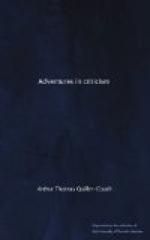Now Jonathan Swift and Esther Johnson and Esther Vanhomrigh really lived; and by living, became historical. But Mrs. Woods sets forth to translate them back into fiction, not as subordinate characters, but as protagonists. She has chosen to work within the difficult limits I have indicated. But there are others which might easily have cramped her hand even more closely.
A Tale of Passion to be told in Terms of Reason.
The story of Swift and Esther Vanhomrigh is a story of passion, and runs on the confines of madness. But it happened in the Age of Reason. Doubtless men and women felt madness and passion in that age: doubtless, too, they spoke of madness and passion, but not in their literature. And now that the lips are dust and the fiery conversations lost, Mrs. Woods has only their written prose to turn to for help. To satisfy the pedant she must tell her story of passion in terms of reason. In one respect Thackeray had a more difficult task in Esmond; for he aimed to make his book a reflection, in every page and line, of the days of Queen Anne. Not only had he, like Mrs. Woods, to make his characters and their talk consistent with that age; but every word of the story is supposed to be told by a gentleman of that age, whereas Mrs. Woods in her narrative prose may use the language of her own century. On the other hand, the story of Esmond deals with comparatively temperate emotions. There is nothing in Thackeray’s masterpiece to strain the prose of the Age of Reason. It is pitched in the key of those times, and the prose of those times is sufficient and exactly sufficient for it. That it should be so is all the more to Thackeray’s honor, for the artist is to be praised in the conception as duly as in the execution of his work. But, the conception being granted, I think Esther Vanhomrigh must have been a harder book than Esmond to write.
For even the prose of Swift himself is inadequate to Swift. He was a great and glaring anomaly who never fell into perspective with his age while he lived, and can hardly be pulled into perspective now with the drawing materials which are left to us. Men of like abundant genius are rarely measurable in language used by their contemporaries; and this is perhaps the reason why they disquiet their contemporaries so confoundedly. Where in the books written by tye-bewigged gentlemen, or in the letters written by Swift himself, can you find words to explain that turbulent and potent man? He bursts the capacity of Addison’s phrase and Pope’s couplet. He was too big for a bishop’s chair, and now, if a novelist attempt to clothe him in the garments of his time, he splits them down the back.
It is in meeting this difficulty that Mrs. Woods seems to me to display the courage and intelligence of a true artist. She is bound to be praised by many for her erudition; but perhaps she will let me thank her for having trodden upon her erudition. In the first volume it threatened to overload and sink her. But no sooner does she begin to catch the wind of her subject than she tosses all this superfluous cargo overboard. From the point where passion creeps into the story this learning is carried lightly and seems to be worn unconsciously. Instead of cataloguing the age, she comprehends it.




